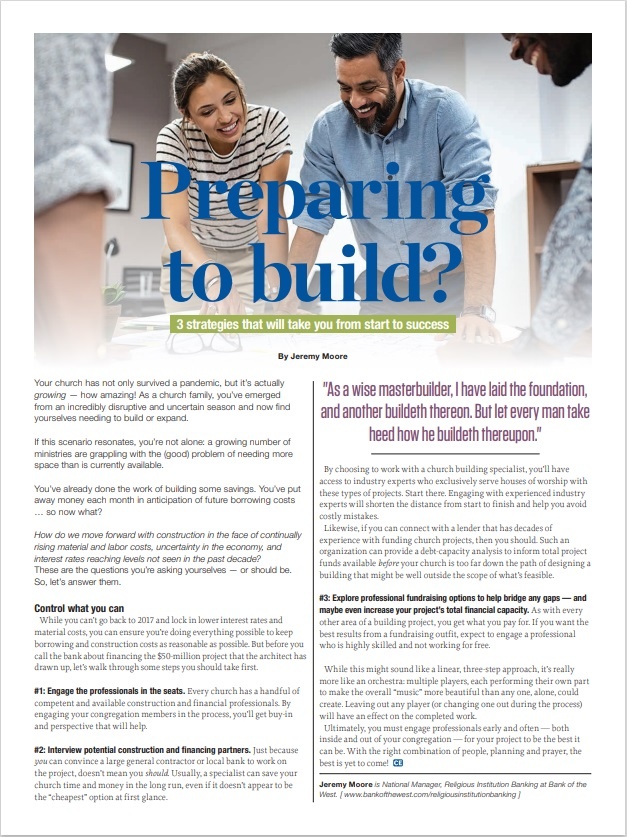
3 strategies that will take you from start to success
By Jeremy Moore
Your church has not only survived a pandemic, but it’s actually growing — how amazing! As a church family, you’ve emerged from an incredibly disruptive and uncertain season and now find yourselves needing to build or expand.
If this scenario resonates, you’re not alone: a growing number of ministries are grappling with the (good) problem of needing more space than is currently available.
You’ve already done the work of building some savings. You’ve put away money each month in anticipation of future borrowing costs … so now what?
How do we move forward with construction in the face of continually rising material and labor costs, uncertainty in the economy, and interest rates reaching levels not seen in the past decade?
These are the questions you’re asking yourselves — or should be.
So, let’s answer them.
Control what you can
While you can’t go back to 2017 and lock in lower interest rates and material costs, you can ensure you’re doing everything possible to keep borrowing and construction costs as reasonable as possible. But before you call the bank about financing the $50-million project that the architect has drawn up, let’s walk through some steps you should take first.
#1: Engage the professionals in the seats. Every church has a handful of competent and available construction and financial professionals. By engaging your congregation members in the process, you’ll get buy-in and perspective that will help.
#2: Interview potential construction and financing partners. Just because you can convince a large general contractor or local bank to work on the project, doesn’t mean you should. Usually, a specialist can save your church time and money in the long run, even if it doesn’t appear to be the “cheapest” option at first glance.
“As a wise masterbuilder, I have laid the foundation, and another buildeth thereon. But let every man take heed how he buildeth thereupon.”

By choosing to work with a church building specialist, you’ll have access to industry experts who exclusively serve houses of worship with these types of projects. Start there. Engaging with experienced industry experts will shorten the distance from start to finish and help you avoid costly mistakes.
Likewise, if you can connect with a lender that has decades of experience with funding church projects, then you should. Such an organization can provide a debt-capacity analysis to inform total project funds available before your church is too far down the path of designing a building that might be well outside the scope of what’s feasible.
#3: Explore professional fundraising options to help bridge any gaps — and maybe even increase your project’s total financial capacity. As with every other area of a building project, you get what you pay for. If you want the best results from a fundraising outfit, expect to engage a professional who is highly skilled and not working for free.
While this might sound like a linear, three-step approach, it’s really more like an orchestra: multiple players, each performing their own part to make the overall “music” more beautiful than any one, alone, could create. Leaving out any player (or changing one out during the process) will have an effect on the completed work.
Ultimately, you must engage professionals early and often — both inside and out of your congregation — for your project to be the best it can be. With the right combination of people, planning and prayer, the best is yet to come!
Jeremy Moore is National Manager, Religious Institution Banking at Bank of the West.


